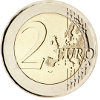 |
C o m m e m o r a t i v e
C o i n s |
||
| ⇑ 2021 ⇑ | |||||||
| 2022 | |||||||
| Image | Country | Date | Feature | Ref. | Volume | ||
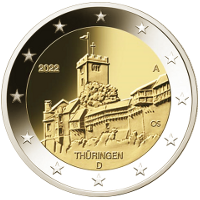 🔎
🔎 |
 |
Germany | 25 Jan. 2022 | Thuringia (Wartburg Castle) 17th coin in the Federal States series |
20003 20005 |
30,424,900 |  |
 Work in progress |
|||||||
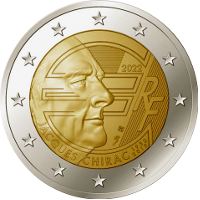 🔎
🔎 |
 |
France | 25 Jan. 2022 | 90th birthday of former President Jacques Chirac |
20003 20005 |
9,020,000 |  |
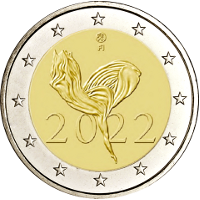 🔎
🔎 |
 |
Finland | 11 Feb. 2022 | 100th anniversary of the Finnish National Ballet |
20003 20005 |
400,000 |  |
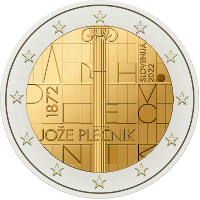 🔎
🔎 |
 |
Slovenia | 02 Mar. 2022 | 150th birthday of the architect Jože Plečnik |
20003 20005 |
1,000,000 |  |
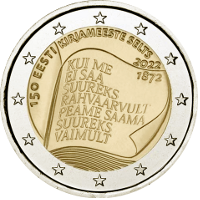 🔎
🔎 |
 |
Estonia | 09 Mar. 2022 | 150th anniversary of the Society of Estonian Literati |
20003 20005 |
1,000,000 |  |
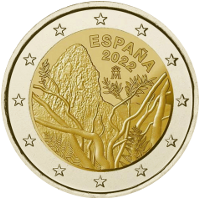 🔎
🔎 |
 |
Spain | 23 Mar. 2022 | Garajonay National Park 13th coin in the UNESCO Wourld Heritage Sites series |
20003 20005 |
1,019,300 |  |
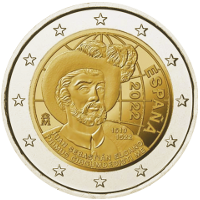 🔎
🔎 |
 |
Spain | 23 Mar. 2022 | 500th anniversary of the completion of the first circumnavigation |
20003 20005 |
1,019,000 |  |
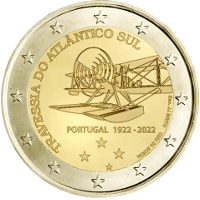 🔎
🔎 |
 |
Portugal | 30 Mar. 2022 | 100th anniversary of the first crossing of the South Atlantic by plane |
20003 20005 |
1,015,000 |  |
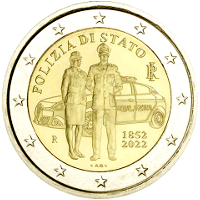 🔎
🔎 |
 |
Italy | 06 Apr. 2022 | 170th anniversary of the foundation of the Polizia di Stato |
20003 20005 |
3,000,000 |  |
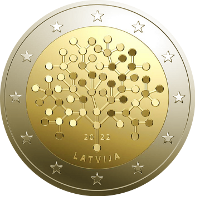 🔎
🔎 |
 |
Latvia | 12 Apr. 2022 | 100 years of Bank of Latvia |
20003 20005 |
415,000 |  |
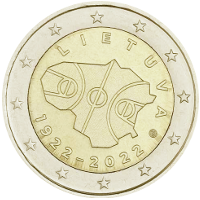 🔎
🔎 |
 |
Lithuania | 21 Apr. 2022 | 100 years of Basketball in Lithuania |
20003 20005 |
750,000 |  |
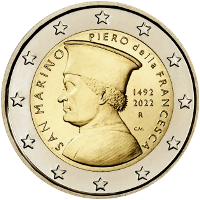 🔎
🔎 |
 |
San Marino | 28 Apr. 2022 | 530th anniversary of the death of Piero della Francesca |
20003 20005 |
57,300 |  |
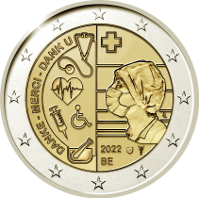 🔎
🔎 |
 |
Belgium | 11 May 2022 | Publicly funded health care |
20003 20005 |
155,000 |  |
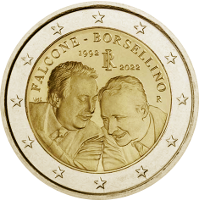 🔎
🔎 |
 |
Italy | 17 May 2022 | 30th anniversary of the death of Giovanni Falcone and Paolo Borsellino |
20003 20005 |
3,000,000 |  |
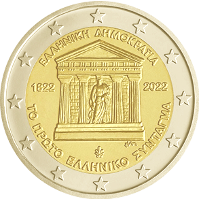 🔎
🔎 |
 |
Greece | 01 Jul. 2022 | 200th anniverasy of the first Greek Constitution |
20003 20005 |
750,000 |  |
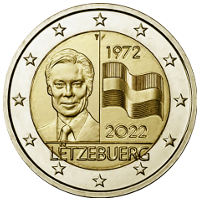 🔎
🔎 |
 |
Luxembourg | 01 Jul. 2022 | 50th anniverasy of the legal protection of the Flag of Luxembourg 27th coin in the Grand‐Ducal Dynasty series |
20003 20005 |
261,000 |  |
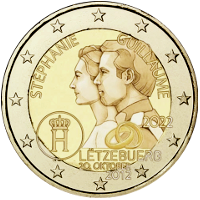 🔎
🔎 |
 |
Luxembourg | 01 Jul. 2022 | 10th wedding anniversary of Hereditary Grand Duke Guillaume and Hereditary Grand Duchess Stéphanie 28th coin in the Grand‐Ducal Dynasty series |
20003 20005 |
261,000 |  |
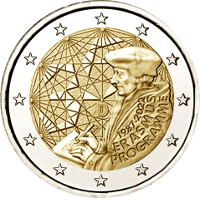
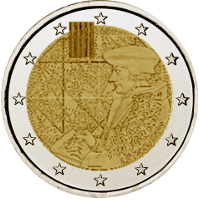 🔎
🔎 |
 |
Common Issue | 01 Jul. — 17 Nov. 2022 |
35th anniversary of the Erasmus Program |
20003 20005 20009 |
35,503,000 |  |
In deviation from this, Luxembourg coins also feature a latent image of the monogram of Grand Duke Henri in the top left‐hand corner, as Luxembourg law does not allow a national coin to be issued without the effigy of the head of state (or at least not without his monogram). |
|||||||
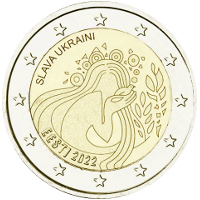 🔎
🔎 |
 |
Estonia | 08 Jul. 2022 | Slava Ukraini |
20003 20005 |
2,040,000 |  |
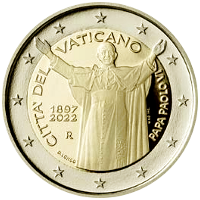 🔎
🔎 |
 |
Vatican City | 06 Sep. 2022 | 125th birthday of Pope Paul VI |
20003 20005 |
79,250 |  |
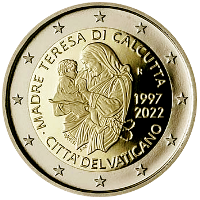 🔎
🔎 |
 |
Vatican City | 06 Sep. 2022 | 25th anniversary of the death of Mother Teresa of Culcutta |
20003 20005 |
79,250 |  |
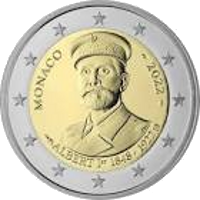 🔎
🔎 |
 |
Monaco | 07 Sep. 2022 | 100th anniversary of the death of Prince Albert I |
20003 20005 |
15,000 |  |
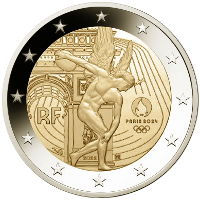 🔎
🔎 |
 |
France | 22 Sep. 2022 | The Genius and the discus throw ‐ Arc de Triomphe 2nd coin in the series on the Olympic Summer Games Paris 2024 |
20003 20005 |
260,000 |  |
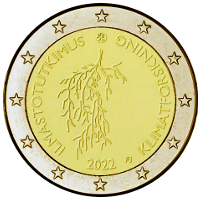 🔎
🔎 |
 |
Finland | 30 Seb. 2022 | Climate research in Finland |
20003 20005 20009 |
400,000 |  |
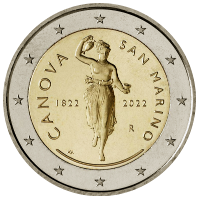 🔎
🔎 |
 |
San Marino | 04 Oct. 2022 | 200th anniversary of the death of Antonio Canova |
20003 20005 20009 |
57,300 |  |
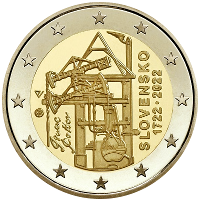 🔎
🔎 |
 |
Slovakia | 05 Oct. 2022 | 300th anniversary of the construction of continental Europe’s first atmospheric steam engine for draining mines |
20003 20005 20009 |
1,000,000 |  |
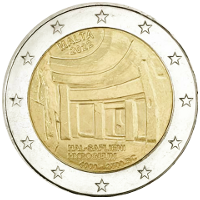 🔎
🔎 |
 |
Malta | 17 Nov. 2022 | Hypogeum of Ħal‐Saflieni 7th coin of the Maltese Prehistoric Sites series |
20003 20005 20009 |
180,000 |  |
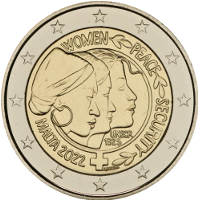 🔎
🔎 |
 |
Malta | 17 Nov. 2022 | United Nations Security Council Resolution on Women Peace and Security |
20003 20005 20009 |
53,000 |  |
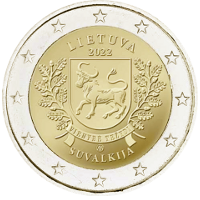 🔎
🔎 |
 |
Lithuania | 20 Dec. 2022 | Suvalkija 4th coin in the series on Lithuanian Ethnographical Regions |
20003 20005 20009 |
500,000 |  |
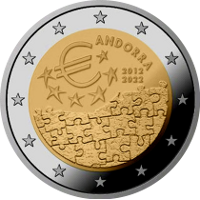 🔎
🔎 |
 |
Andorra | 16 Jan. 2023 | 10th anniversary of the monetary agreement between Andorra and the European Union |
20003 20005 20009 |
70,000 |  |
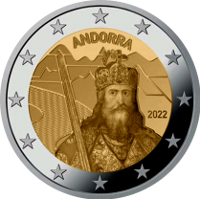 🔎
🔎 |
 |
Andorra | 16 Jan. 2023 | The legend of Charlemagne |
20003 20005 20009 |
70,000 |  |
| ⇓ 2023 ⇓ |
| References : | |||
| 20001 | Images taken with authorisation by the ECB - Mail dated 20.Feb.2020 © "European Central Bank" |
20002 | Data mirrored from Wikipedia Page "2_euro_commemorative_coins" with friendly support of the guardians of that page. |
| 20003 | Images taken with authorisation by H....... Hamburg | 20004 | Coloured version of this Commemorative Coin in circulation EU‐legal‐technical specifications do not recongnise colour prints. The EU nevertheless tolerates them, as their numbers are very small and they are sold in special packs and therefor are very unlikely to be used as currency. |
| 20005 | enlarged Images taken with authorisation by Gerd Seyffert © "Gerd Seyffert 2021" |
20006 | Not Applicable |
| 20007 | Images taken by Münzen Kreuzberg © "Münzen Kreuzberg 2021" |
20008 | enlarged Images taken by Münzen Kreuzberg © "Münzen Kreuzberg 2021" |
| 20009 | Text with kind permission by Gerd Seyffert © "Gerd Seyffert 2023" |
20010 | Not Applicable |
 |


